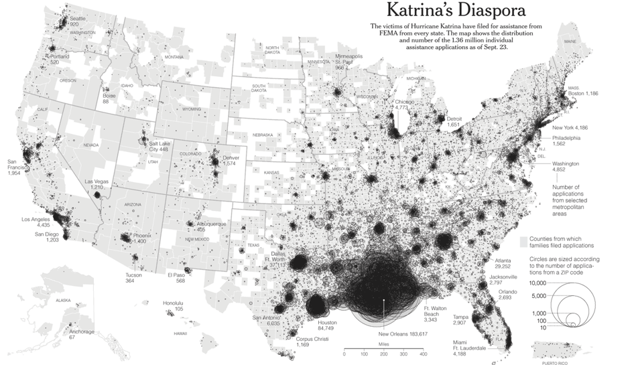Hurricane Katrina's Uncharted Diaspora
The storm displaced hundreds of thousands from their homes, and there is still no comprehensive picture of where they ended up.
Hurricane Katrina made landfall in the city of New Orleans on the morning of August 29, 2005, swept in by winds traveling at 127 mph. But the true damage came after the levees broke, when about 80 percent of the city flooded. At least400,000 residents, nearly the entire city, were displaced—some for a few days, some forever.
What we do have are a handful of individual studies, lists, and mapping efforts, that, taken all together, paint a portrait of a decade of dramatic upheaval.
The New Orleans ‘Diaspora’
In the hours before, during, and after the storm, New Orleanians evacuated to cities and towns all over the country. Sometimes they chose a destination in order to be with family or friends. Other times, FEMA sent them off to places unknown. “We have residents who were loaded onto buses bound for Memphis or Salt Lake City and only found out once they got there,” says Michelle Whetten, vice president of the affordable housing and community development nonprofitEnterprise Community Partners, Inc.
But FEMA captured just a snapshot of the displacement, and in the broadest stokes. Narayan Sastry, a scholar of population studies at the University of Michigan and a social scientist at the RAND Corporation, has been developingsurvey-based methods of tracking displaced New Orleanians since 2009. In a2014 paper, Sastry used a sample of individual responses from the Census Bureau’s American Community Survey (ACS) to examine where New Orleans residents wound up in the year after the hurricane, and what factors had influenced their moves.
By one year out, about 53 percent of displaced adult New Orleanians in Sastry’s sample were back again, with less than a third at the home they’d lived in prior to Katrina. Of those who remained displaced, 12 percent were living elsewhere in Louisiana (particularly Baton Rouge), and 40 percent were in Texas (particularly Dallas and Houston, the latter receiving more evacuees than anywhere else). Most of the rest were scattered throughout the South, or New York, Ohio, and California.
“Most of the displaced adults likely faced considerable economic and Mapping the Displacement of Katrina Survivors - The Atlantic:

